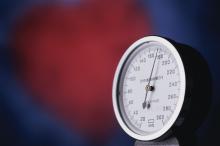Continuous blood pressure monitoring is significantly better than in-office measurements at predicting the risk of cardiovascular events and death, although the additional prognostic benefit is quite small, wrote Wen-Yi Yang, MD, and colleagues. Their report is in JAMA.
In light of this finding, 24-hour monitoring is probably best reserved for select patients – especially those with white coat hypertension, and those who self-report hypertension but test within normal parameters in the office, said Philip Greenland, MD, Harry W. Dingman Professor of Cardiology at Northwestern University, Chicago, who wrote a perspective piece published along with the study.
“The good news is that, for the average patient, the office measurement is highly predictive and performs extremely well,” Dr. Greenland said in an interview. “Ambulatory monitoring will get you very little additional information. But if you are getting a 24-hour reading, the measures you probably want to focus on are the nighttime pressures and the overall 24-hour average.”
Dr. Yang of the University of Leuven, Belgium, and his team were “trying to make sense of this huge amount of data that’s available now that ambulatory blood pressure monitoring systems are much more common,” Dr. Greenland said. “The real clinical question is, ‘If I’m getting all this information, how do I interpret it?’ ”
To investigate this, the authors evaluated blood pressure and cardiovascular outcomes among more than 11,000 subjects enrolled in the International Database on Ambulatory Blood Pressure in Relation to Cardiovascular Outcome (IDACO).
The median individual follow-up was about 14 years, although some patients were followed up to 22 years. All told, the study posted 153,140 person-years of follow-up. These patients were a mean of 55 years old at enrollment; almost 12% had a history of cardiovascular disease. Most (83%) had three automated in-office blood pressure measurements; 5% had two, and 2% had a single measurement. There were 55 24-hour ambulatory readings, 28 for daytime only, and 11 for nighttime.
The mean in-office automated BP was 135/82. The mean 24-hour BP was 123/74; the mean daytime pressure, 130/79; and the mean nighttime pressure, 113/65.
The authors recorded blood pressure–dipping status: 50% were normal, 18% had extreme dipping, 25% had no dipping, and 6% had reverse dipping. The mean dipping ratio was 0.87.
A regression analysis adjusted for sex, age, body mass index, smoking, and alcohol use, serum cholesterol, antihypertensive drugs, cardiovascular disease and diabetes.
Over the entire study period, there were 2,836 deaths and 2,049 cardiovascular events – a rate of 13.4 per 1,000 person-years. Both cardiovascular events and mortality were significantly associated with all ambulatory BP measurements, compared with in-office measurements. For nighttime systolic BP, the hazard ratio for mortality was 1.23 and 1.36 for cardiovascular events. For the 24-hour measure, the HR for mortality was 1.22, and for cardiovascular events, 1.45. Hazard ratios represented the risk associated with a 20–mm Hg higher systolic blood pressure or a 0.10 difference in dipping ratio.
However, the area under the curve for a single, in-office systolic BP was quite good, at 0.83 for mortality and 0.84 for cardiovascular events. Adding 24-hour measurements or nighttime systolic BP to the model resulted only in very, very small “incremental” improvements in AUC of 0.0013 and 0.0027, respectively
“The current population-based study confirmed previous research indicating that ambulatory BP monitoring over and beyond measures taken in clinicians’ offices improved risk stratification among patients with or suspected of having hypertension,” The authors wrote. “It strengthened the notion that nighttime BP measures carry valuable prognostic information.”
However, they admitted that the addition these measures offer to the AUC for BP measurements was “incremental.”
“This metric is not very sensitive in model comparisons if the basic model performs well, as was the case in the current study. … The prevailing perception among experts is that BP is the strongest modifiable risk factor. The small increments in change in the AUC challenge this concept. Thus an important issue in the evaluation of an additional risk prediction marker is how to interpret a small AUC increase, which many researchers believe is an imprecise metric because it increases only slightly with the introduction of an additional marker in multivariable-adjusted models, even if the marker under study carries great risk, as reflected by the odds ratio (or HR).”
One investigator, Krzysztof Narkiewicz, MD, reported receiving lecture fees from numerous pharmaceutical and device companies. No other disclosures were reported.
SOURCE: Yang W et al. JAMA. 2019;322(5):409-20.


